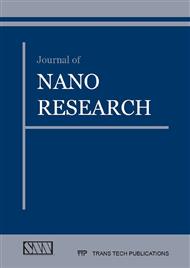[1]
Z. Bhimani and B. Wilson, New low cost ferrofluidic sealing challenges the mechanical seal, Ind. Lubr. Tribol. 49 (1997), 288-290.
DOI: 10.1108/00368799710189507
Google Scholar
[2]
A. Hatch, A. E. Kamholz, G. Holman, P. Yagerand K. F. Bohringer, A Ferrofluidic Magnetic Micropump, J. Microelectromech. Syst. 10(2001), 215-221.
DOI: 10.1109/84.925748
Google Scholar
[3]
Z. F. Gan, J.S. Jiang ,Y. Du. B. Yang, M. Qian and P. Zhang, Immobilization of homing peptide on magnetite nanoparticles and its specificity in vitro, J. Biomed. Res. 84 (2008), 10-18.
DOI: 10.1002/jbm.a.31181
Google Scholar
[4]
J. S. Jiang,Z. F. Gan, Y. Du .B. Yang, M. Qian and P. Zhang, A novel magnetic fluid based on starch-coated magnetite nanoparticles functionalized with homing peptide, J. Nanopart. Res. 11(2009), 1321-1330.
DOI: 10.1007/s11051-008-9534-5
Google Scholar
[5]
Y. Yang, J. S. Jiang, Z. F. Gan, Qian M and P. Zhang, Preparation and properties of a novel drug delivery system with both magnetic and biomolecular targeting, J. Mater. Sci. Mater. Med. 20(2009), 301-307.
DOI: 10.1007/s10856-008-3577-0
Google Scholar
[6]
R. Saidur, K. Y. Leong and H. A. Mohammad, A review on applications and challenges of nanofluids, Renewable and Sustainable Energy Reviews15(2011), 1646-1668.
DOI: 10.1016/j.rser.2010.11.035
Google Scholar
[7]
S. U. S. Choi, Nanofluid technology: current status and future research, Proceedings of the Korea-US Technical Conference on Strategic Technologies Vienna, USA, 22-28 (1998).
Google Scholar
[8]
B. D. Murray, Local enhancement of heat transfer in a particulate cross flow—I Heat transfer mechanisms, Int. J. Multiphase Flow20(1994), 493-504.
DOI: 10.1016/0301-9322(94)90023-x
Google Scholar
[9]
L. Fedele, L. Colla, S. Bobbo,S. Barison and Agresti, Experimental stability analysis of different water-based nanofluids, Nanoscale Research Letters6(2011), 1-8.
DOI: 10.1186/1556-276x-6-300
Google Scholar
[10]
Y. Hwang and J. K. Lee, Production and dispersion stability of nanoparticles in nanofluids, Powder Technology186(2008), 145-153.
Google Scholar
[11]
S. M. S. Murshed, K. C. Leong and C. Yang, Thermophysical and electrokinetic properties of nanofluids–a critical review, Appl. Therm. Eng. 28(2008), 2109-2125.
DOI: 10.1016/j.applthermaleng.2008.01.005
Google Scholar
[12]
Y. He, Rapid Thermal Conductivity Measurement with a Hot Disk Sensor. Part 1: Theoretical Considerations, ThermochimicaActa436(2005), 122-129.
Google Scholar
[13]
V. H. Grassian, "When Size Really Matters: Size-Dependent Properties and Surface Chemistry of Metal and Metal Oxide Nanoparticles in Gas and Liquid Phase Environments, Journal of Physical Chemistry C 112(2008), 18303-18313.
DOI: 10.1021/jp806073t
Google Scholar
[14]
S. Bobbo, L. Colla and M. Scattolini, Thermal conductivity and viscosity measurements of water-based silica nanofluids, Proceedings of the Nanotech Conference and Expo, Boston, Mass, USA, June (2011).
Google Scholar
[15]
M. A. Jamal, M. K. Khosa, A. B. Yousaf and S. Naz, Ultrasonic Studies on Magnetite (Fe3O4)Nanoparticles, Journal of Nanofluids3(2014), 1-7.
Google Scholar
[16]
A. B. Yousaf, M. Khan, M. Imran, M. Usman, M. A. Jamal, Influence of particle size on density, ultrasonic velocity and viscosity of magnetite nanofluids at different temperatures, Nano 9 (2014), 1450089.
DOI: 10.1142/s1793292014500891
Google Scholar
[17]
Z. Junwu, L. Dan, H. Chen, X. Yang, L. Lu and X. Wang, Highly dispersed CuO nanoparticles prepared by a novel quick-precipitation method, Material Letters58(2004), 3324-3327.
DOI: 10.1016/j.matlet.2004.06.031
Google Scholar
[18]
G. M. J. Pastoriza, C. Casanova, J. L. Legido and M. M. Pineiro, CuO in water nanofluid: Influence of particle size and polydispersity on volumetric behaviour and viscosity, Fluid Phase Equilibria300 (2010), 188-196.
DOI: 10.1016/j.fluid.2010.10.015
Google Scholar
[19]
T. X. Phuoc and M. Massoudi, Experimental observations of the effects of shear rates and particle concentration on the viscosity of Fe2O3–deionized water nanofluids, International J. Thermal Sciences, 48(2009), 1294-1301.
DOI: 10.1016/j.ijthermalsci.2008.11.015
Google Scholar
[20]
B. Hawrylak, R. Palepu and P. R. Tremaine, Thermodynamics of Aqueous Methyldiethanol-amine (MDEA) and Methyldiethanolammonium Chloride (MDEAH+ Cl-) over a Wide Range of Temperature and Pressure: Apparent Molar Volumes, Heat Capacities, and Isothermal Compressibilities,J. Chem. Thermodyn. 38 (2006).
DOI: 10.1016/j.jct.2005.10.013
Google Scholar
[21]
J. F. Zhao, Z. Y. Luo, M. J. Niand K. F. Chen, Dependence of Nanofluid Viscosity on Particle Size and pH Value, Chin. Phys. Lett. 26(2009), 066202.
Google Scholar
[22]
D. O. Masson, Solute molecular volumes in relation to solvation and ionization, Phil. Mag. 79(1929), 218-235.
Google Scholar
[23]
R. Kiruba, M. Gopalakrishnan, T. Mahalingamand S. J. Kingson, Ultrasonic Studies on Zinc Oxide Nanofluids, Journal of Nanofluids1 (2012) , 97.
Google Scholar
[24]
M. T. Zafarani-Moattar andR. Majdan-Cegincara, Effect of temperature on volumetric and transport properties of nanofluids containing ZnO nanoparticles poly(ethylene glycol) and water, J. Chem. Thermodynamics, 54(2012) 55-67.
DOI: 10.1016/j.jct.2012.03.010
Google Scholar
[25]
O. Kratky, H. Leopold and H. Stabinger, The determination of the partial specific volume of proteins by the mechanical oscillator technique, Methods Enzymol. 27(1973), 98-110.
DOI: 10.1016/s0076-6879(73)27007-6
Google Scholar
[26]
A. Apelblat, E. Manzurola and Z. Orekhova, Thermodynamic Properties of Aqueous Electrolyte Solutions. Volumetric and Compressibility Studies in 0. 1 mol·kg−1, 0. 5 mol·kg−1, and 1. 0 mol·kg−1 Sodium Carbonate and Sodium Sulfate Solutions at Temperatures from 278. 15 K to 323. 15 K, J. Chem. Eng. Data54 (2009).
DOI: 10.1021/je900108f
Google Scholar


